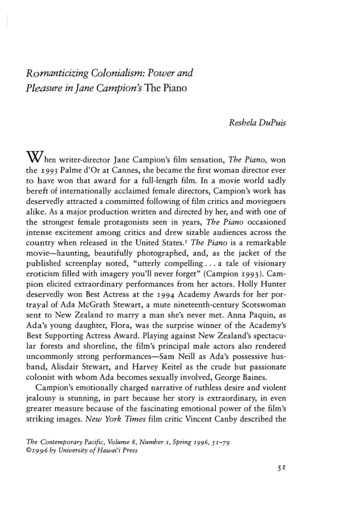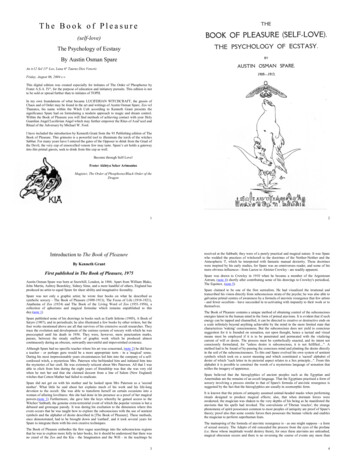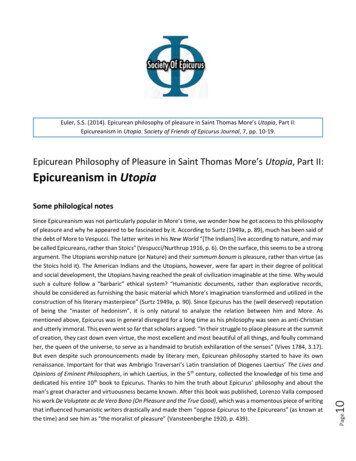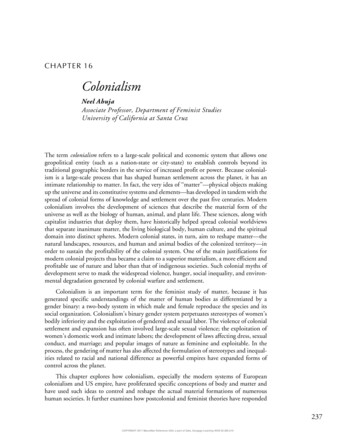
Transcription
Romanticizing Colonialism: Power andPleasure in Jane Campion's The PianoReshela DuPuisWhen writer-director Jane Campion's film sensation, The Piano, wonthe I993 Palme d'Or at Cannes, she became the first woman director everto have won that award for a full-length film. In a movie world sadlybereft of internationally acclaimed female directors, Campion's work hasdeservedly attracted a committed following of film critics and moviegoersalike. As a major production written and directed by her, and with one ofthe strongest female protagonists seen in years, The Piano occasionedintense excitement among critics and drew sizable audiences across thecountry when released in the United States. 1 The Piano is a remarkablemovie-haunting, beautifully photographed, and, as the jacket of thepublished screenplay noted, "utterly compelling . a tale of visionaryeroticism filled with imagery you'll never forget" (Campion 1993). Campion elicited extraordinary performances from her actors. Holly Hunterdeservedly won Best Actress at the 1994 Academy Awards for her portrayal of Ada McGrath Stewart, a mute nineteenth-century Scotswomansent to New Zealand to marry a man she's never met. Anna Paquin, asAda's young daughter, Flora, was the surprise winner of the Academy'sBest Supporting Actress Award. Playing against New Zealand's spectacular forests and shoreline, the film's principal male actors also rendereduncommonly strong performances-Sam Neill as Ada's possessive husband, Alisdair Stewart, and Harvey Keitel as the crude but passionatecolonist with whom Ada becomes sexually involved, George Baines.Campion's emotionally charged narrative of ruthless desire and violentjealousy is stunning, in part because her story is extraordinary, in evengreater measure because of the fascinating emotional power of the film'sstriking images. New York Times film critic Vincent Canby described theThe Contemporary Pacific, Volume 8, Number I, Spring I99 6, JI-79 I996 by University of Hawai'i Press
THE CONTEMPORARY PACIFIC· SPRING199 6film as "a severely beautiful, mysterious movie that, as if by magic, liberates the romantic imagination" (1993). Film critic Stella Bruzzi celebratedthe film as a brilliant depiction of a woman's "sexual and emotionalawakening" (1993, 6). And Jane Campion herself claimed that the filmwas a way for her to explore "the romantic impulse." In the epigraph toher screenplay, she wrote, "It's a heroic path and it generally endsdangerously. I believe it's a path of great courage. It can also be thepath of the foolhardy and the compulsive" (1993). In the notes to thescreenplay, she declared the link between romance and "the pure sexualerotic impulse" to be primarily, "a relationship of power," and admitted,"I'm very very interested in the brutal innocence of that" (Campion 1993,7, 139)·Yet for all its beauty and power, The Piano is much more than justone woman's vision of a classic nineteenth-century European romance, apotentially tragic love triangle transported to a far outpost of the empire.The film contains graphic, highly eroticized scenes of sexual and physical violence against its main female character, including coerced sex,attempted rape, and brutal dismemberment. More subtly, but for thatreason more significantly, the film's sexual symbolism relies heavily onprofoundly racist depictions of the indigenous Maori people of NewZealand, and on culturally coded, deeply racialized representations oftheir land. Race and sex are not ideologically separate categories in thisfilm. Along with evocative class-specific social markers, the relationshipsbetween them serve to establish relationships between the film's whitecharacters. They function constantly to reconstruct and represent oneanother metonymically as well as metaphorically, through the systematicassociation of female and male desire with categories of racial difference.Campion's intense, emotionally riveting images employ a specific sexualand racial graphic coding, a multilayered technology of knowledge production that Native American critic Laura Donaldson has in othercircumstances termed colonial "graph(t)ology" (Donaldson 199 2 , 56).Campion's twentieth-century story of liberating passion both relies onand reproduces nineteenth-century western colonial mythologies of sexand race, the fundamental "relationships of power" from which she hasfashioned her spellbinding vision of desire.This article explores how The Piano succeeds in transposing nineteenth-century sex-and-race-bound colonial structures of meaning onto atwentieth-century colonialist narrative of romance, and examines the
DUPUIS· POWER AND PLEASURE IN CAMPION'S PIANO53underlying political implications of that transposition. I use the wordcolonialist here to distinguish twentieth-century western global hegemonyfrom its nineteenth-century "colonial" predecessor. In arguing that thefilm is "colonialist," I analyze the ways that, through its processes ofcreating knowledge, it both emerges from and engages in the earliersystem's ideological project of sustaining white, western, male-dominantglobal economic and political superiority. The operations of the nineteenth century's dominant colonial discourses are strikingly embedded inThe Piano's twentieth-century colonialist symbolic system; "embedded"here is meant to suggest qualities both of being hidden and formative ofinternal structures. Functioning as a precise technology of meaning production, these embedded discourses reconstitute the colonial past the filmseeks to symbolically represent in ways that position that past obliquely,to both the film's twentieth-century audiences and their nations' supposedly "postcolonial" dominance.Sited both in and outside the movie theater, that oblique positionality isinstrumental in sustaining ongoing global constructions of white, westernpolitical authority, and, as cultural critic Susan Jeffords suggested, is bothinteractive with and conducive to the larger multinational global remappings of late capitalism (pers comm 1994; 1989). Thus, the film imagines,and creates, a viewing subject positioned directly at the center of its act ofconstructing history, a viewer who is also constructed by the film as theexclusively white western subject of a colonialist present. Building on thework of feminist film critic Laura Mulvey, Teresa de Lauretis has arguedthat such a viewing subject position also dominantly constructs maleness,because it is both sited at and sights through the cultural conventions bywhich the camera's cinematic eye produces and reproduces the "malegaze" of voyeuristic patriarchy (de Lauretis 1987,99).Like all cultural productions that use strategies of representation toproduce knowledge-that is, all cultural productions-The Piano isinherently engaged in a politics of the relations of power. Readers familiarwith Campion's self-avowed detachment from politics may find myapproach unwarranted. After all, she has specifically cautioned that she is"averse to teaching messages." "I think it's quite clear," Campion hasclaimed, "that my orientation isn't political or doesn't come out of modern politics" (Cantwell 1993,44). However, despite her avowal that ThePiano is merely an apolitical romance, through both its "visible" narrative plot and the "invisible" film vocabulary of mise-en-scene, camera
54THE CONTEMPORARY PACIFIC· SPRINGI99 6angle, shot, and editing technique, it reproduces some of the oldest patriarchal fantasies about women's sexual desire around. It does so byencoding its sexist ideology in systematically racist and class-specific cinematographic practices that reconstruct nineteenth-century colonized NewZealand as a backdrop for the reproduction of the race, sex, and classhierarchies of the contemporary western system. Campion's attempt tomask her film's underlying significating formalism in a narrative of romantic passion set in an ahistorical fantasy world has barely disguised hercovert project of authorizing a gendered, racialized, and distinctly contemporary colonialism. The film could hardly be more political.THE FILMA brief narrative synopsis of the film is in order here. In the mid-nineteenth century, Ada McGrath, whose will is "strange and strong" (Campion I993, IIS) enough to self-impose life-long muteness, is sent to NewZealand to enter an arranged marriage with a Scots male colonist, Alisdair Stewart. She takes along her apparently illegitimate young daughter,Flora, with whom she shares a language of hand signals, and her piano,through which she vividly expresses her emotions. Not understanding itsimportance, her husband-to-be refuses to transport the piano to her newhome in the interior, leaving it on the deserted beach where Ada haslanded. Difficult from this inauspicious start, their relationship remainsstrained. Stewart's compatriot, George Baines, who has become integrated enough into native Maori society to sport facial moko 'tattoos,'becomes interested in Ada. He trades Stewart 80 acres of land for thepiano and the promise of lessons from Ada, a bargain with which Stewartforces her to comply. During the earliest of those lessons, however, Bainesoffers Ada a different trade-she can earn back her piano, one key at atime, in exchange for sexual favors. Soul-sick, desperately lonely, andeffectively silenced without her music, Ada agrees. Thus begins a long,tortuous relationship in which Baines becomes increasingly obsessive anddemanding while Ada adamantly resists his passionate emotions, if nothis lustful and occasionally violent physical demands.Meanwhile, forced to remain outside during the lessons, Flora becomesalienated from her mother. During a sulky outburst, she tells Stewart thatBaines never plays the piano during the lessons. Eventually, believing thatAda does not and never will care for him, Baines gives Ada back herpiano. Suspicious, Stewart follows Ada to Baines' cabin, where Baines
DUPUIS· POWER AND PLEASURE IN CAMPION'S PIANO55declares his love for her and she, through the intensity of look and gesture, reveals her passion for him. They make love while, unbeknown tothem, Stewart watches through cracks in the cabin walls and floor. Thenext day, Stewart again follows Ada, but this time he intercepts her in thebush and attempts to rape her. Interrupted by Flora, he boards up bothwife and daughter inside his cabin. In the ensuing days and nights, Adabegins acting strangely. She plays the piano in her sleep and becomesdeeply absorbed in her own reflection in a hand mirror. Ultimately, sheinitiates sensuous, erotic nightly episodes with Stewart which she silentlyand utterly controls. He finally unboards the cabin, Ada promises not tosee Baines again, and Stewart leaves to continue fencing his land.But Ada cannot keep her promise. She removes a key from her cherished piano and inscribes it with a message of enduring devotion for herillicit (and unfortunately illiterate) lover. She orders Flora to take the keyto Baines, but the child, in a fit of willfulness as strong as her mother's,delivers it instead to Stewart. Enraged, he returns and, in front of Flora,chops off one of Ada's fingers. He forces Flora to take the bloody appendage to Baines with the message that he'll cut off another if Bainesattempts to see Ada again. As Ada lies feverish and delirious, her mangledhand wrapped in dirty bandages, Stewart caresses her and once againattempts to have sex with her. Ada awakens, and a curious, nonverbalcommunication occurs between them. Forced by Ada's silent will, Stewartagrees to give Ada and Flora to Baines, and the three of them, along withthe piano, are taken away in a Miiori canoe.During the trip, Ada demands that the piano be pushed overboard. Asit goes down, she deliberately slips her foot into the ropes that had lashedit to the canoe and is pulled into the ocean, saving herself from drowningonly at the last moment by kicking off her boot and struggling to the surface. She and Baines set up house in the town of Nelson, where he makesher a replacement metal fingertip and she begins to learn to speak. In anodd and, for some viewers, uncomfortable twist, the final scene of themovie shows Ada dreaming of herself drowning again, tied to her pianoin a "cold grave, under the deep, deep sea."SILENT MEANINGS, MEANINGS SILENCEDThe exact location and specific time period in which the action occursremain vague. It is unclear, for example, whether the story takes placebefore or after the 1840 signing of the Treaty of Waitangi, or before, dur-
56THE CONTEMPORARY PACIFIC· SPRING199 6ing, or after the Anglo-Maori land wars of the 1860s. Most of the film'saction takes place in an equally indeterminate location somewhere in theNew Zealand bush, which Campion's screenplay variously describes as an"enchanted, complex, even frightening," place and a "dark, inner world"of "almost prehistoric [sic] density" (Campion 1993, 139, 142). Although Campion celebrates the film's "[c]ross cultural collaboration"exemplified by the large Maori cast, many of whom wear traditionaltribal maka-the specific tribal identities of the Maori characters theyplay remain as poorly differentiated as the story's historical and locational contexts. Almost without exception, these characters remain unnamed in the film's predominantly English or infrequently subtitledMaori dialogues. This lack of specificity about the movie's Maori characters gives rise to questions about just how fully involved were the "Maoriadvisors and writers [who] helped create the story" (Campion 1993, 142).The film's historical and dialogic silences do not merely signal theabsence of cultural meaning. The fact that so little historical informationis made explicit in the film forces its targeted international, but largelywhite western, audience to rely on their own culturally bound preconceptions regarding British colonial history in New Zealand, including assumptions based on dominant centuries-old Euro-American colonial discourses. This reliance on traditional colonial notions organizes the film'sown contemporary representational practices to such an extent that itreproduces the earlier era's fundamental, and tenaciously vicious, patternsof hierarchical dualism. Colonial power relations structure meaning inboth the film's narrative text and its "facade of impersonal technology"(Brennan 1990, 67), which together constitute its practices of knowledgeproduction. Through its refusal to engage the problematic and multiplenarratives of the colonial past, the film implicitly reinscribes that past'sdominant mythology of sexual and racial difference in the present.To a cynical western world grown weary of pitiful tales about downtrodden victims, overt representations of sexual oppression and colonialracism simply are no longer appealing-if they ever really were. Campionis far too gifted a filmmaker to allow her provocative romantic fiction oferotic self-discovery to be overshadowed by the too-crude presence ofconcrete sexist and racist power politics. They might spoil the audiences'romantic pleasure. Instead, she artfully conceals them in an exquisitepattern of impressionistic motifs. Constructing extraordinarily powerfultensions between sound and silence, sight and blindness, she offers her
DUPUIS· POWER AND PLEASURE IN CAMPION'S PIANO57audience a fictive world in which sound and sight are ingeniously imbricated with each other, piled up like foliage in the lush New Zealand bush,experienced in sensory rushes of almost staggering power.From its title to the fetishized object of that title, from the haunting, attimes overpowering musical score to the notion of speech suppressed,sound and its absence infuse The Piano with a surreal aura of emotionalintensity. Holly Hunter's piano solos function as forcefully in the film asdoes her ability to convey a wide range of emotions in absolute silence.Like her character Ada's self-enforced muteness, the presence of evocative"natural" sounds functions almost as a persona-ocean waves crash onbarren shores, incessant rain pounds rooftops, exotic birds call throughthick forests in counterpoint to the lack of human conversation. As well,Campion's reliance on the act of seeing as a cinematic device marks bothknowing and the refusal to know, what can be seen and what must notbe. Perception thus appears to order the film's visual ontology, parallelingits insistently emotive soundtrack. Her obvious familiarity with feminists'criticisms of the "male gaze" permeates her film with a sometimes painful, and occasionally ironic, awareness of the "symbolic eye." Near thestory's beginning, for example, the already-jealous husband, AlisdairStewart, peers possessively at his new bride through the lens of a camera.Ada sits dressed in flimsy wedding lace, easily torn, refusing to look backat him. Later, of course, drawn by the sound of her illicit lovemaking, hewill stare at her through a crack in Baines' cabin wall as her clothes aretorn from her by her compulsive lover. In visually and musically stunningscenes like these, Campion employs sight and sound as epistemologicaltools, metaphors within the film's romanticized narrative that seek tocontain other, less benign, symbols.Neither cryptic vision nor dramatic musical expressionism, however,adequately explains the foundational cultural notions on which the film ispatterned and through which it makes sense of its visual and aural components. Thinking through how the visual, dialogic, and narrative mechanisms work permits an examination of the contradictory meaningsbehind what is seen and heard. Such an analysis reveals the director's conspicuous attempt to "see past" the masculine colonial gaze, by ironicallyforegrounding it, as a failure-at least in part, because of her insistenceon grounding her own practices of meaning production in the very colonial hierarchies through which that gaze has traditionally functioned. Thefilm's literal reproduction of the masculine, race-specific colonial gaze
THE CONTEMPORARY PACIFIC· SPRING199 6constructs its own and its viewers' positions from directly inside thatworldview's center. The film masks but does not disrupt, and ultimatelyaccepts that positionality with its obscurantist attempts to re-encode itselfas romance.Representative of this complicit camouflaging is the film's openingscene. Light and shadow play across indistinct figures on a movingscreen. Viewers soon discover they are seeing through Ada's eyes, whichshe has covered with her fingers, perhaps symbolic in the film's iconography of her later refusal to know her own desire. At the same time, theyhear her voice, but immediately discover that they have not really heardher at all. "The voice you hear is not my speaking voice, but my mind'svoice," she says in the film's opening line. Thus, they are led to believethey are privileged to hear Ada's inner voice, with which she can tell her"real" story without the mediation of the masculine ownership of logos,language. But if her real voice is not her speaking voice, then is the eye,through which viewers supposedly see, her own real inner eye/I? Whatwill Ada's gaze see? And whose story will her not-speaking voice speak?I argue that, beginning with this very first scene, the film consistentlyconstructs Ada's complex narrative through an "eyell" whose white,western, and ultimately male gaze is fundamental to Campion's colonialist schematic. For example, in the first of only two speeches the audiencehears from this inner voice (the other is the last speech in the film), Adarelates that, having been married by her father to a man she's not yet met,she is to travel with her daughter to their new home in "his own country"(Campion 1993, 9). The rest of her speech concerns her thoughts abouther silence, her new husband, and her piano. The curious phrase "hisown country" goes unmarked, submerged in a personal narrative ofstrong will and hidden emotions. But listen to it- Chis own country"! IfNew Zealand (or more properly in its indigenous Maori language,Aotearoa) belongs to Alisdair Stewart or to any other nineteenth-centurywhite man, it does so only as a consequence of the violence of genocidalimperialism. The history of Maori resistance to the eighteenth- and nineteenth-century European invasion of their homelands reveals one of thebloodiest, and longest, records of defiance in the annals of western colonialism. Yet, through its cinematographic discourse, the film privilegesthat colonial ownership.This is a curious choice for a film written by a Pakeha 'white' NewZealander in the mid-1980s and directed by her in the early 1990S.2 By
DUPUIS· POWER AND PLEASURE IN CAMPION'S PIANO591984, the year in which Campion began writing her screenplay, decadesof Maori political protest and confrontation with the mostly Pakeha NewZealand government had resulted in the reempowerment of the WaitangiTribunal, designed to rectify some of the more gross injustices perpetratedon the indigenous peoples since the signing of the treaty (Ward 199 1, 87).As well, that year also saw the publication of Maori activist Donna Awatere-Huata's collection of nationalist essays, Maori Sovereignty, whichclaims that Pakeha dominance in New Zealand is not only racist "cultural imperialism," but also illegally subverts the Maori version of thetreaty (see Ihimaera 1993, 108). As Pakeha law professor Andrew Sharphas noted, the 1980s were a decade in which Maori political, legal, andsocial protests, including protests over the substitution of the Englishname, New Zealand, for the Maori one, Aotearoa, forced a nationwidereexamination of the country's colonial past and its current institutionalpower inequities (Sharp 1990, 4). In his introduction to a volume ofMaori-authored political essays, writer and activist Witi Ihimaera stated,"There has been no other decade quite like the I980s, for these were theyears in which Maori people once again stood up, spoke out and refusedto sit down until they had their say. We found our voice in theI980s. The 1990S are utterly different as a consequence" (Ihimaera1993,16).The context of the current political struggles of both Maori andPakeha to come to terms with their shared history breaks through Campion's seemingly subtle reliance on what one reviewer has called her"elliptical way of examining the past" (Bruzzi 1993, 10). Althoughactress Holly Hunter claimed she was attracted to the script partlybecause of the "vast dimension of things being unexplained to the audience or even to the characters" (Campion 1993, 149), it is the overwhelming historical evidence of "Pakeha trickery and aggression in earlycolonization . of the general tendency of Pakeha law and policy to ride,booted and spurred, over the Maori people" (Sharp 1990, 3-4) that sojarringly unsettles the film's antihistorical and supposedly apolitical ambiguity. So strongly does acknowledgment of the brutality of the Britishinvasion of the Maori's homelands disrupt the film's romanticizing visionof nineteenth-century sexual politics that feminist critic Sara Halprin feltjustified in arguing that the "Maori subplot" must have been intended byCampion as a "parallel example of power" to the love story, throughwhich she could depict the "misuse and the resulting violence" of that
60THE CONTEMPORARY PACIFIC· SPRING1996power (Halprin 1994, 35). In Halprin's view, therefore, Campion's representation of "Maori frustration that they and the land they hold sacredare treated as objects by the colonist Stewart" should be read as a progressive, even pro-Maori attempt to address the long history of whitecolonial violence in Aotearoa (Halprin 1994, 35).It is neither my place nor my purpose to present Maori or Maori-centered narratives of that history here. Maori historians continue to tell themultiple, interweaving stories of their waka 'canoe,' iwi 'tribe,' and hapu'subtribe', both through the traditional forms of haka 'chant,' whaikorero'oration,' and waiata 'song', and increasingly within the conventions ofthe western academic historical profession. What I can and must do, as awestern feminist cultural critic, is contest the argument that such "parallelsubplotting" within what Campion herself has called a "European story"(1993, 142) constitutes a revisionist, antiracist or anticolonialist perspective. Critiquing another colonial-era film, Dances with Wolves, whichmany viewers also celebrated as pro-native and antiracist, Robert Appleford has argued that such "romanticized" films "can be useful as an empowering tool if [their] attempt to present a humanized native constructfosters attention to native issues and concerns outside of the movie theater. If, however, such films encourage a type of solipsism involving ourown non-native obsessions, the creatures that emerge from 'behind therocks' will inevitably look like grotesque versions of ourselves" (1995,I I 6). Through its representational practices, both narrative and cinematic, The Piano seeks to contain possibly disruptive, unsettling attentionto current Maori concerns, and to conceal the operations of its own gender-and-race-bound constructions of historical meaning. It does so by displacing a politics of critical historical analysis onto the intricate,passionately pleasurable structural tensions of western romantic myth.SI( GH)TED BODIES, EMBODIED LANDWithout question, this is a cinematic masterpiece of potent pleasure. Alarge portion of that pleasure lies in Campion's richly filmed, visually sensuous images of Maori bodies. Sliding smoothly through deep water,tattooed muscles gleaming as they carry heavy burdens through denseundergrowth, these brown bodies mesmerize the white western gaze.They confound its sense of normalcy through a creative visual mixture ofpartial nudity and an odd assortment of western clothes. Compounding
DUPUIS· POWER AND PLEASURE IN CAMPION'S PIANO61their powerful collective visual presence is the intriguing aural texture oftheir-to most viewers-unfamiliar Maori dialogue.Quite literally, without these bodies, the film would have difficultymoving forward, for these bodies tangibly carry the burden of the story.Images of Maori carrying the colonizers' cargo-the piano, Ada's heavyboxes and trunks-also labor in the film's ideological project of reproducing modern colonialism. Though the Maori appear to be "really there,"authentic, agentive subjects of their own complex and fascinating lives,the structural context within which those on-screen lives supposedlyoccur is without content. These Maori have no homes, no villages, noexplicit relationships with each other or the colonizers. Their manifestlyprofuse material presence subsumes autonomous questions about theirhistorical presence in the film, and more important, functions to containuncomfortable questions about how the film's history came to be sited intheir land in the first place.Earlier, I argued that no nineteenth-century white man could be said toown Maori land except at the price of imperialist expansionism. Now, Iwant to also argue that through its celebratory but contextless presentation of Maori bodies, the film implacably ignores the contemporary heritage of their relationships to the colonial past, in turn operating to cocreate the ongoing consequences of that heritage for both privilegedPakeha and "marginalized" Maori (Vercoe 1990, 83). The land in whichthese fictitious Maori labor is the same land in which the contemporaryMaori actors who play them also labor-a land in which the vast majority of the Maori people are institutionally, economically disadvantaged.Like their dispossessed nineteenth-century ancestors, contemporary Maoricontinue to be paid poorly for their labor in a capitalist economy imposedon their stolen land by white colonial invaders.Their land, like their bodies, figures centrally in the film's productionof modern colonialist knowledge about the earlier colonial era. Throughout the film, the land of Aotearoa is portrayed as a "natural" (thus naturalized) metaphor for exotic, unnatural desire. It is clearly opposed to thesafe, orderly world of white civilization that Ada and the other Britishcolonists have left behind, and which some of them strive to recreate inthe muddy, "primitive" Other. Both the "exotic" land and its "savage,""wild" natives are appropriated by Campion's camera-just as they werephysically and discursively appropriated by the nineteenth-century Britishcolonists-and are used as graphically descriptive and metaphorically
62THE CONTEMPORARY PACIFIC· SPRING199 6symbolic background markers in a cinematographic practice that transcribes "their" attributes onto her "real" (read white) characters. Invariably, these white characters and their relationships with each other arerepresented in terms of their relationships, either noble or ignoble, to the"savage exoticism" of the land and its indigenous inhabitants. Nor is thisuse of the land and its people particularly subtle. New York Times filmcritic Caryn James candidly noted that Baines' "affinity with nature issuggested by the Maori tattoos on his face" (James 1993). As a review ofthe film in a midwest American newspaper explicitly stated, "the rawpower of the remote bush serv[es] as backdrop . to [Ada's] anger andpassion" (Current, Dec 1993, 29).More than just serving as an evocative natural landscape, however,Campion's exploitative use of the Maori's homeland also functions as ahighly schematic and inherently conservative political tool. After an aweinspiring view of massive cliffs rising above a vast wave-swept beach, thefirst full view of the land to which Ada has been sent is one that westernviewers of colonial-era films find extremely familiar. From a high-flyinghelicopter, the camera sweeps over thick forest as the soundtrack swellswith strangely haunting music. A shot-dissolve-shot sequence of the lush,green, almost impenetrable mountain canopy races across the screen.Suddenly, western viewers recognize this place-they have seen it befo
piano and the promise oflessons from Ada, a bargain with which Stewart forces her to comply. During the earliest ofthose lessons, however, Baines offers Ada a different trade-shecan earn back her piano, one key at a time, in exchange for sexual favors. Soul-sick, desperately lonely, and effectively silenced without her music, Ada agrees.










